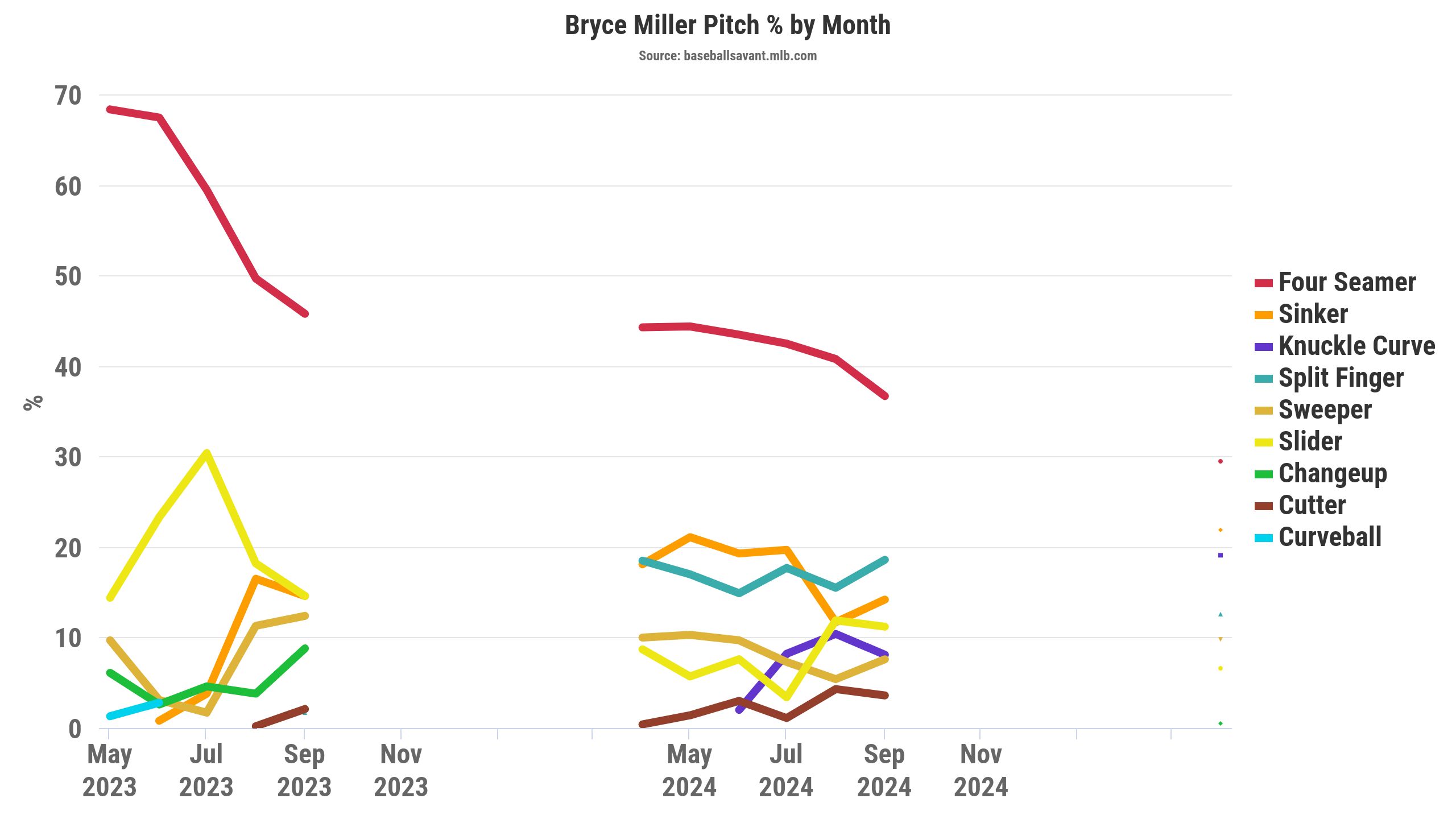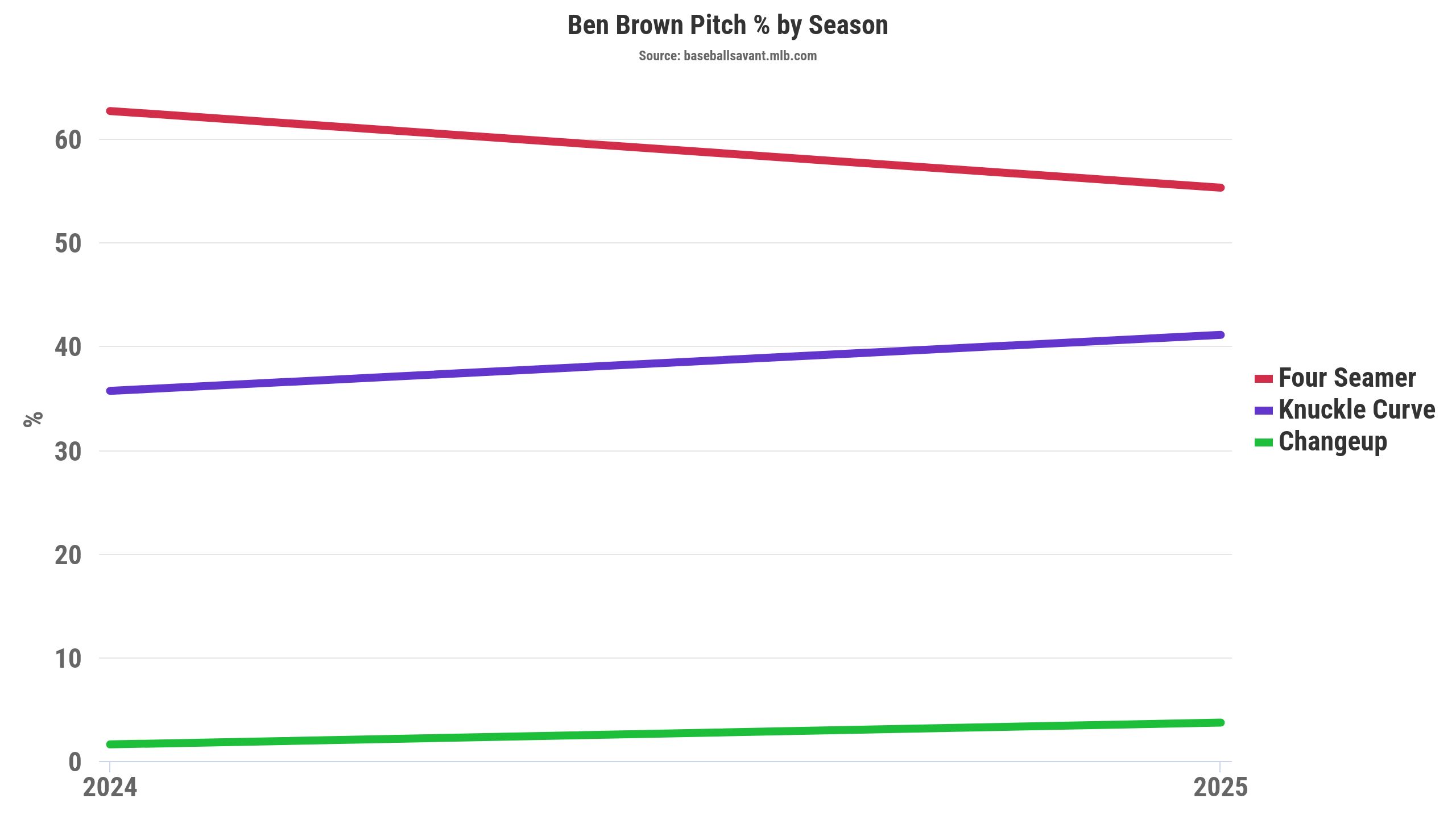Corbin Young examines several fantasy baseball pitcher risers and sleepers displaying changes in their pitch mix, movement, and velocity heading into Week 3 (2025).
Welcome back, RotoBallers, to my weekly "Starting Pitcher Arsenal Changes" article series for Week 3 of the 2025 fantasy baseball season. Today's article will discuss several starting pitchers who made actionable changes, like a release point change or a new pitch. For those new to this column, we cover a few starting pitchers and their arsenal changes via pitch mix, velocity, and movement each week.
Since it's early, we're looking for new pitches, velocity, and movement changes. With these pitchers having a limited sample of starts, we'll tread lightly to have confidence in identifying any differences or similarities. If we find significant release point shifts, it can potentially impact their movement profiles in 2025.
Pitchers can make notable changes in smaller samples, so let's see if we can find something with these starting pitchers. Statcast introduced pitch percentage splits by left- or right-handed batters, which adds a nice layer to compare quickly to past seasons. Let's look through my process of examining starting pitchers and their arsenals. Reach out to me on X if you have a pitcher you have questions about. This is the second article of this series for the 2025 season. Thank you for reading!
Be sure to check all of our fantasy baseball lineup tools and resources:- Fantasy baseball trade analyzer
- BvP matchups data (Batter vs. Pitcher)
- PvB matchups data (Pitcher vs. Batter)
- Who should I start? Fantasy baseball comparisons
- Daily MLB starting lineups
- Fantasy baseball closer depth charts
- Fantasy Baseball live scoreboard
- Fantasy baseball injury reports
Bryce Miller is Evolving Again With More Knuckle Curves
Through Miller's two starts, he has been throwing more knuckle curves (19.1 percent) after only using it 4.5 percent of the time in 2024. He continues to evolve after introducing the splitter last season and a knuckle curve in 2025.
Miller's knuckle curve has been his best pitch for whiffs in the early 2025 sample, eliciting a 31.4 percent swinging strike rate. It's about 1 mph slower than last season, but the knuckle curve possesses over six inches more downward movement. It added 1.5 inches of glove-side movement, but additional vertical drop would be the most notable.
Given Miller's high arm angle (44 degrees), it shifts even higher (47 degrees) when throwing the knuckle curve, likely contributing to the downward movement being nearly 51 inches. The knuckle curve was effective against left-handed hitters (.212 wOBA, .210 xwOBA) in the small 2024 sample.
It's been similarly effective (.253 wOBA, .253 xwOBA) in 2025 versus lefties, as the usage spiked to 28.4 percent, his second-most-used pitch behind the four-seamer (29.6 percent). We've seen Miller gradually lower the four-seamer usage to become less predictable against either side of the plate. However, Miller's four-seam remains a juicy heater with over 19 inches of induced vertical break.
Summary
Miller's arsenal keeps evolving. It's hard not to wonder if more knuckle curves will detract from the splitter whiffs. We've seen an early shift with the splitter losing over two inches of downward movement in 2025 versus 2024. Regardless of that speculation, Miller has multiple pitches to attack both sides of the plate. It's not easy for starting pitchers to develop new pitches and be effective, but Miller has been doing just that.
Ben Brown Needs a Third Pitch
Sometimes starting pitchers can survive with two primary pitches, though we typically see that occur with relievers. Brown's arsenal looks like a reliever, though he lowered the four-seam usage by nine percentage points in 2025, with an uptick in knuckle curves by six points.
Brown's knuckle curve movement profile hasn't changed much. It added about an inch more of downward movement and one inch of glove-side sweep. His knuckle curve elicits a 27.1 percent swinging strike rate, over two percentage points above 2024. Besides that, Brown's four-seamer possesses slightly above-average levels of IVB (17.2 inches) with high-end extension (6.9 feet).
Brown's high-end extension allows the four-seam to potentially garner whiffs with the IVB if he locates in the upper third of the zone, which he attempts sometimes. The four-seam can generate a few whiffs, but hitters have been crushing it, with a .403 wOBA (.383 xwOBA) in 2025, similar to his .401 xwOBA in 2024.
Brown needs a third pitch, whether it's more changeups, a sinker, or something to attack left-handed hitters. We haven't had a significant sample of changeups to evaluate since he only threw around 20-25 in his career. Or maybe a cutter or something that doesn't have drastic pitch separation from the four-seam and knuckle curve.
Summary
Brown's current arsenal makes him predictable, with four-seamers up in the zone and curveballs typically going down and away from right-handed hitters. Since Brown seems like a supinator, maybe a sweeper or slider would be helpful. He'll need something to pair with the four-seam and knuckle curve, especially since he can be a one-pitch pitcher if one isn't working.
Sean Newcomb's New Cutter
Newcomb has been so far removed from my memory that I wouldn't have been able to tell you what team he pitched for before making the Red Sox rotation. Let's bring Newcomb back into our consciousness with the cutter (28.5 percent) leading the arsenal to work off the four-seam (23.4 percent).
The last time we saw Newcomb throw cutters at a high rate was back in 2022 (27.4 percent) and 2021 (22.5 percent). However, Newcomb's cutter looks new and different in 2025. That's evident in his cutter losing five inches of downward movement. Typically, some of the better cutters don't drop as much as his previous cutter, so that's a positive change in 2025.
Unfortunately, right-handed hitters have been destroying Newcomb's cutters (.739 wOBA, .438 xwOBA) in 2025. However, Newcomb's four-seamer has elicited more whiffs (25 percent SwK) versus righties with better results (.000 wOBA, .001 xwOBA) through two starts. Those might be fluky results for the four-seamer based on the pitch shape and movement.
When we look past the outcomes for Newcomb's cutter, the inputs intrigue us as an offering to generate weak contact in the future. Newcomb's arsenal will give us more confidence if the slurve remains effective against left-handed hitters, with the cutter performing better against righties. Though we didn't discuss the changeup, that's another pitch to monitor if he continues to use it more versus righties.
Summary
The Red Sox starting pitchers made notable shifts last season under Andrew Bailey, moving away from throwing four-seamers as often. Newcomb fits that mold by throwing fewer four-seamers and more cutters in 2025. That worked well for Kutter Crawford, Brayan Bello, and others to increase their breaking ball usage. Keep tabs on Newcomb's arsenal, though he might not be more than a deep league streaming option.
Brandon Pfaadt's New Curveball, Maybe
Over the weekend, I posted about a new pitch and usage alert for Pfaadt, specifically the curveball. Baseball Savant initially had Pfaadt throwing a curveball to right-handed hitters 41 percent of the time to the Nationals on April 4. However, it may have been a pitch classification issue because Pfaadt's Savant player page shows sweepers as the lead offering against righties.
That's notable because he typically threw sinkers (30.9 percent) and four-seamers (27.9 percent) besides sweepers (38.6 percent) in 2024 versus right-handed hitters. Pfaadt's curveball has more depth (43.3 inches) than his sweeper (33.3 inches). We mention Pfaadt having a newer curveball (maybe) because of the movement profile changes compared to 2024.
Pfaadt has been throwing his curveball harder (83.8 mph), 3 mph more than in 2024. That led to Pfaadt's curveball losing nearly seven inches of downward movement. We've seen Pfaadt throw more curves to left-handed hitters in 2025 (25 percent), up from 10.1 percent in 2024, a significant change.
He traded fewer four-seamers for more changeups (29.2 percent) and curves to opposite-handed hitters, which should lead to better outcomes. Unfortunately, that hasn't occurred yet in 2025 with the four-seam (.468 wOBA, .558 xwOBA), changeup (.369 wOBA, .527 xwOBA), and curveball (.519 wOBA, .403 xwOBA).
However, based on Pfaadt's curveball location (low or below the zone) and swinging strike rate against lefties (33.3 percent SwK), it looks like a positive change in his arsenal.
Summary
Pfaadt's best pitch for whiffs has been his sweeping slider, so adjusting his curveball shape makes sense. This feels like Nick Pivetta of previous years, where Pfaadt teases us with the tools and skills, but the results haven't followed. We might need to be patient and ride it out with Pfaadft as he works through those changes. Expect some rough patches.
Download Our Free News & Alerts Mobile App
Like what you see? Download our updated fantasy baseball app for iPhone and Android with 24x7 player news, injury alerts, sleepers, prospects & more. All free!






 RADIO
RADIO




































